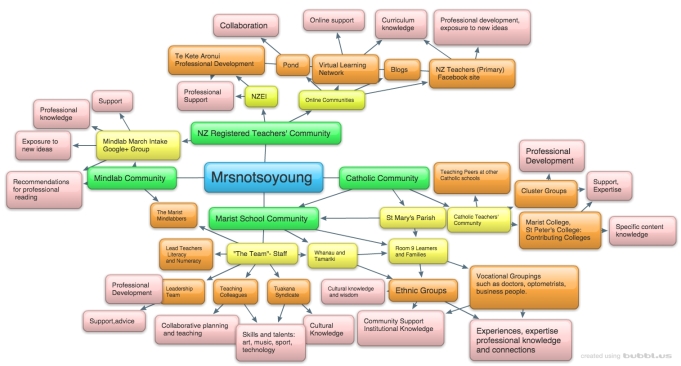I actually had fun with this one!
**Herman Melville’s quote comes from http://www.goodreads.com/quotes/156835-we-cannot-live-only-for-ourselves-a-thousand-fibers-connect
This map shows my current connections. It begins in the middle- with me. My closest and largest connections- my fibres-are in green.These centre around my school community and link quite directly with the wider Catholic community, both parish and educational.The community of NZ primary teachers has far-reaching links in both support and in professional development.This year, one of my most powerful connections has been via Mindlab. From there, my connection links move out, with the outermost subsets being the benefits I currently gain from these connections.
Another of the potential benefits of digital communities is the opportunity it can offer my community of learners to extend their understandings through easily accessible Interdisciplinary learning.The New Zealand Curriculum summarises the usage of e-learning as assisting in” the making of connections by enabling students to enter and explore new learning environments, overcoming barriers of distance and time.(“Effective pedagogy,” 2007, p.36). Jacobs defines interdisciplinary learning as a ‘knowledge view and curriculum approach that consciously applies methadology and language from more than one discipline to examine a central theme, topic, issue, problem or work.”(as cited in “What is interdisciplinary learning?”, 2004.) If this is so, then the conscious component is important.The fibres which connect new and existing learning need to be real rather than forced. It is the fibres themselves which reinforce the strength of each discipline as a standalone entity, and it is exploring the connections which builds understanding. I want to explore the possibilities of resources such as http://www.learnz.org.nz/. It seems to me that this is a user-friendly way of exposing my learners to a wide range of experts and to an equally wide range of experiences.
Then, I want to move from digital to real-life experts by finding ways to use a resource literally right on our doorstep, the neighbouring secondary school.The possibilities of working to include the expertise of specialist teachers of science, languages or technology are exciting. Similarly, extending our connections across our parent and parish community,with their links to knowledge and experiences, allows us to draw on multiple talents and points of view in order for our learners to acquire deeper, more personal understandings (Mathison & Freeman,1997).
There would be challenges to overcome. Hardre, P. L.,et al (2013) discuss the importance of creating a collaborative community in order to enhance the value of interdisciplinary learning.This would need planning, professional conversations and time. Hardre et al ( 2013,p.410) go on to say that it is “getting out of familiar and comfortable spaces and immersion in novel and challenging experiences ” which facilitates deeper learning..An interesting video to watch which discusses interdisciplinary teaching, albeit in a secondary school, is https://www.teachingchannel.org/videos/collaborative-teaching-ntn. As one of the teachers featured in this says, “The real world is not siloed into disciplines.”It would be interesting to look at the impact, not just on learners, but on both primary and secondary teachers if we worked across the two schools.
References:
Hardre, P. L., Ling, C., Shehab, R. L., Nanny, M. A., Nollert, M. U., Refai, H., …Wollega, E. D. (2013). Teachers in an interdisciplinary learning community: engaging, integrating, and strengthening K-12 education. Journal of Teacher Education, 64(5), 409+. Retrieved from http://libproxy.unitec.ac.nz:2048/login?url=http://ic.galegroup.com/ic/bic1/AcademicJournalsDetailsPage/AcademicJournalsDetailsWindow?failOverType=&query=&prodId=BIC1&windowstate=normal&contentModules=&display-query=&mode=view&displayGroupName=Journals&limiter=&currPage=&disableHighlighting=false&displayGroups=&sortBy=&search_within_results=&p=BIC1&action=e&catId=&activityType=&scanId=&documentId=GALE%7CA350677367&source=Bookmark&u=per_unit&jsid=d8e5a8bef76eae0bef3f6e00df19ffc8
Interdisciplinary learning in your classroom. (2004). Concept to Classroom.WNET Education. Retrieved from http://www.thirteen.org/edonline/concept2class/interdisciplinary/
Mathison, S., & Freeman, S. (1997). The logic of interdisciplinary studies. Paper presented at the Annual Meeting of the American Educational Research Association, Chicago. Retrieved from http://www.albany.edu/cela/reports/mathisonlogic12004.pdf
Ministry of Education.(2007). Effective pedagogy. Wellington, New Zealand:Learning Media. Retrieved from http://nzcurriculum.tki.org.nz/The-New-Zealand-Curriculum
Teaching Channel. (2015). Collaborative teaching for interdisciplinary learning. Retrieved from https://www.teachingchannel.org/videos/collaborative-teaching-ntn


An interesting diagram and review of where you stand and where you see yourself being in the next year or so! I am sure while doing this you reflected on the strength of your links and your observation that you were more often on the receiving end than the giving end may be more true with your IT initiatives but not, I know, with your immediate and perhaps long- standing links.
To me your observation then is about embedding practice…… over time you have formed connections which benefit your teaching and learning and with whom you share your experiences. As you draw towards the end of your Mindlab journey, with continued committment to the pedagogy and practices you have experienced, I feel confdent you will embed these newer connections and as your trust in the connections develops you will share your thought and practices more frequently with others.
LikeLike
The possibility of sharing the expertise with the specialist teachers from the neighbouring secondary school is excellent as a local learning community. It will also help us to aid the transition of our students to secondary school.
LikeLike